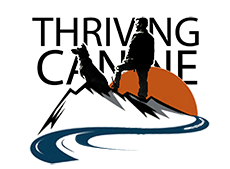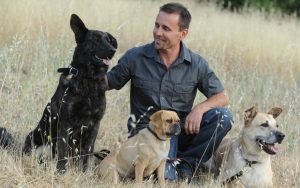 Question: “Hi guys!! My dog has now been crated for 3 months after being hit by a speeding car. She's a tough cookie and made an amazing recovery. She has various screws, pins and metal plates in her hind leg. While I'm excited to have her out of her crate, I'm scared for the worst, as I know she will try to dart out the door at any chance she gets. She likes to chase cars (this is how she got in this situation) Does anyone have recommendations on how to stop her from doing this? We will be going to obedience training as she only knows one basic command ("Sit") but she is very food motivated and will basically do anything for food. lol”
Question: “Hi guys!! My dog has now been crated for 3 months after being hit by a speeding car. She's a tough cookie and made an amazing recovery. She has various screws, pins and metal plates in her hind leg. While I'm excited to have her out of her crate, I'm scared for the worst, as I know she will try to dart out the door at any chance she gets. She likes to chase cars (this is how she got in this situation) Does anyone have recommendations on how to stop her from doing this? We will be going to obedience training as she only knows one basic command ("Sit") but she is very food motivated and will basically do anything for food. lol”
Note: This question was asked on a Facebook dog group. They gave me permission to use it for an article.
Answer: I'm so happy that your dog survived, you are very lucky! Chasing the car caused your dog to get hit but there were foundational things that led up to it. For example: In order to chase the car she had to be in street – in order to be in street she had to be outside and off-leash – in order to be outside without a leash she had to bolt out the door. Obviously we need to address the car chasing but for a more holistic perspective I am going to answer your question in three sections – Management, Training and Fulfillment.
Management:
You need to control, or manage, the environment so mistakes don't happen, or so that when they happen you are able to correct them. For example:
- Keeping doors and gates closed
- Having the dog on leash
- Using a baby gate or ex-pen as an extra boundary at the front door.
Management alone is not enough because at some point it will fail… people leave doors open, leashes slip out of hands, collars break, etc. but it needs to be in place in order to train the dog safely and consistently.
Obedience Training:
Your dog needs obedience training. She doesn't need to learn a million tricks, she just needs to learn a handful of commands really well. The key phrase being really well. Below is my list of recommended commands for your situation.
- Wait: Teach your dog the “Wait” command and practice at every door, every time…religiously…to the point of being obsessive about it. This will create an invisible boundary that will stop the door dashing. Do the same thing at the street, creating a boundary there as well. Have your dog on-leash. Teach the Wait command using body language and stepping into her space as well as physical pressure such as nudging with your leg. If she gets past you simply use the leash to bring her back and try again. DO NOT use a Sit command. This is boundary training, not a Sit-Stay exercise.
- Come: A reliable recall, or “Come” command, is critical. If your dog breaches the door boundary you want to be able to call her back immediately. Teach this on a 50’ long line. Start with low level distractions and use plenty of praise and rewards. If she gets distracted use a light leash pop to bring her attention back to you. Once that is going well move on to various locations with greater distractions. Practice until she is consistently coming with no help from the leash.
- Heel: “Heel” means to walk by your side with no pulling, no sniffing, no barking, no lunging and no car chasing. This can be introduced with treats but ultimately needs to be taught with leash corrections for real world reliability. Introduce the concept with low distractions, then begin Heeling around moving cars. In most cases this can be done in one training session. Practice every day until she is totally desensitized and shows no interest in chasing cars.
- Leave It: The “Leave It” command means “Leave that alone.” This is the most direct command for teaching her that chasing cars is bad, even when she is not under any other command…ultimately even if you are not there at all. You can introduce this command with treat-based games but for any real sense of safety you will need to add corrections to back up your “Leave It” command.
Fulfillment:
A dog with a fulfilling life will be much more receptive to training and less likely to run off. What makes for a fulfilled dog? There could be a million answers to that but below are a few that I believe are essential.
- Exercise: Any healthy dog should get a daily walk of at least 30 minutes. Most will need more than that plus some running activities such as fetch or jogging. Dogs also need mental exercise. This is done through training and teaching impulse control. For example: Long duration Heel, long duration Down-Stay, controlled games of tug and fetch, obedience drills, trick training…these all involve mental exercise, focus and impulse control.
- Socialization: Exposure to various people, places, things and animals is called socialization. A well socialized dog is much more likely to be calm and non-reactive to her environment, including cars going by. The key to proper socialization is controlled exposure, not free-for-all exposure. See my article on The Three Paths To Socialization – Interactive, Engaging and Observatory.
- Leadership: Most dogs don’t want to be the leader, they just want to know there is one. If you don’t fulfill your dog’s need for leadership, she will sense a vacuum and fill it herself. This causes a ton of stress and behavior problems in dogs. A simple way to get started is to follow the Nothing-In-Life-Is-Free plan, which means your dog must work for everything…including your attention. For example: If she jumps on your lap uninvited, don’t pet her. If she is dropping a ball in your lap while you are watching TV don’t throw it. When she is being calm and minding her own business, that’s the time to call her to you for some attention.
Conclusions:
Car chasing is a life threatening behavior. The fastest and most permanent solution would be to use a remote collar (aka shock collar) to stop the car chasing. However, unless I absolutely had to stop this behavior, permanently, in one lesson, I would probably not jump right to that. Since the dog has no foundational training at all and there are other issues at play besides just car chasing, I would prefer the more holistic approach outlined above.
Please keep us updated on your progress.
Check out www.ThrivingCanine.com for more free articles and videos.
-Chad Culp, Certified Dog Trainer and Canine Behavior Consultant
© Thriving Canine 2017



